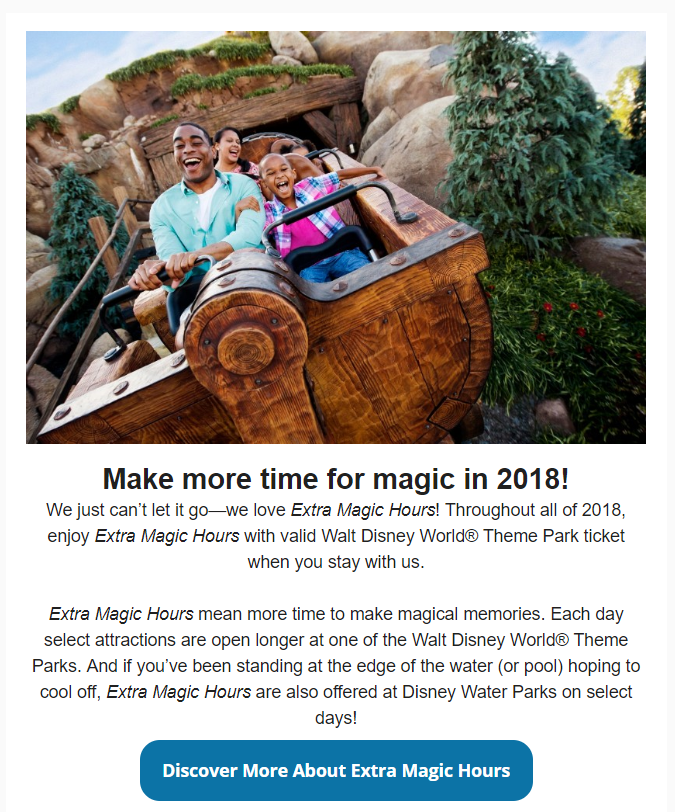Email marketing is a powerful tool in your digital marketing arsenal. According to Hubspot, 59% of marketers say email is their biggest source of ROI. And with 99% of consumers checking their email every day, email marketing is an opportunity to connect with your guests that your hotel cannot afford to miss out on.
Interested but not sure where to begin? Jumpstart your email marketing with this beginner guide on what basic actions to take and what common mistakes to avoid.
Building an Email Marketing List
Do have a sign-up on your website.
Ideally, you should implement sign-up opportunities across multiple parts of your website. A simple call to action button in your footer will make signing up accessible to guests on every page of your site. You can also create a landing page specifically devoted to email sign-ups that can then be pulled up on computers or tablets at your hotel.
Do segment your list from the beginning.
List segmentation is a powerful tool that helps you customize your email marketing to recipients who are most likely to engage with it. For hotels, you can segment your list into categories like business travelers or leisure travelers, meetings planners or wedding planners, and families or individuals. To learn how to segment effectively, check out our guide on optimizing your list.
Don’t buy a list.
Buying a subscriber list is illegal. Not only is it illegal, but most email marketing providers (MailChimp, Constant Contact, etc.) will ban you from sending campaigns if they get multiple reports from subscribers that they never signed up for your emails.
Don’t add recipients to your list without explicit opt-in/consent.
Especially in light of stricter online privacy laws, you want to be as transparent as possible when asking people to sign up for your email list. Make sure your sign-up is GDPR (General Data Protection Regulation) compliant. Do not have a ‘sign up for our newsletter’ box already checked on other unrelated forms.
Email Marketing Template
Do design a template conducive to your brand.
When designing your template, make sure you are using the same fonts, colors, and logos used in your other digital materials. Sometimes specific fonts are not always available in some email clients, so make sure you have generic back-up fonts like sans-serif or serif to use just in case.
Do optimize your design for mobile and different email clients.
Emails look different if you open them in Gmail versus Outlook. These are different email clients, and therefore why emails render differently. Most email marketing providers (MailChimp, Constant Contact, etc.) will allow you to test how your email will look in these different clients. Always test your design in popular clients before sending.
In addition, make sure you are designing with mobile in mind! According to the Hubspot article we mentioned earlier, mobile opens accounted for 46 percent of all email opens. Again, most email marketing providers will allow you to test this before sending.
Don’t rely on an all-image email.
While most email clients will load all-image emails fine, some older email clients and even personal email settings may prevent or distort the images in your email. Include an all-text email with the important headlines, information, and links in your email just in case.
Don’t make your email list opt-out hard to find.
By law, you are required to have an opt-out option in every marketing email you send. For best practices, make sure this is easy to find and complete. One-click unsubscribes are ideal. While you may be sad to see a subscriber go, making the opt-out experience difficult will just make (now former) subscribers angry and hurt their relationship with your brand overall.
Email Marketing Copy Best Practices
Do tailor your voice to the medium of email marketing.
Writing for email is different than writing for social media, your website, or a print medium. Take the time to read up on the latest best email copywriting practices. Overall, always make sure to include a strong call to action that has significance in the design (such as a button). See below for an example. Interested in some help? Get in touch.

Do include pre-header/preview text.
This will inform subscribers what the email is about and will encourage open rates. Write this in conjunction with the subject line; they should be related sentences/phrases, but not the same thing twice.
Don’t make your content all fluff.
There is nothing wrong with icing on the cake, but make your subscriber opening that email worth their while. More and more of marketing, especially in the digital sphere, is content-forward. Your email should be the same.
Don’t be afraid to test different subject lines.
Most email marketing providers offer you the ability to A/B test, including with subject lines. Test different subject lines to the same list and see what performs better. Then use this information to refine future subject lines.
Sending Email Marketing Campaigns
Do tailor your send time to the recipient’s time zone.
If your email marketing provider allows you to send to subscribers based on their time zone, use this feature! It adds a level of personalization that may seem insignificant, but receiving your email at an appropriate time (not in the wee hours of the morning, for example) can make subscribers more likely to open your email.
Do A/B test.
Most email marketing providers allow you to easily A/B test variables like send times, subject lines, and even email content. Experiment with these factors and see what works best for different segments of your subscribers.
Don’t send your email without a thorough check.
Check for errors with the help of tools and at least one additional pair of eyes. Review spelling and grammar with spell check and tools like Grammarly. Click every link in the email and make sure it is going to the correct destination. Send a test email to someone on your team and have them take a look too.
Don’t try to “trick” the promotions tab.
Most modern email clients have some sort of autosorting built in—think of the ‘Promotions’ tab in Gmail. Do not try to trick autosorting! This is actually where you want your email to land. By delivering to the correct category, subscribers feel ready to engage with your content because they know what kind of content it will be.
Email Campaign Analytics
Do track your data.
Your email marketing provider will have some sort of reporting built in, but it is up to you to look at these numbers. Track open rates, click rates, and unsubscribe rates to start before diving into more advanced analytics.
Do something with your data.
Once you have the data from your emails, take action with it! Use the performance numbers to inform your future campaigns. Change up send times, content, subject lines, and more based on data trends.
Don’t let your subscriber list get stale.
Use analytics to tell who is an engaged subscriber versus an unengaged one. Clean those consistently unengaged subscribers from your list or try a re-engagement campaign specifically for them. Keeping a quality list is essential, and we wrote a whole guide on it.
Don’t forget that email marketing works best when used as part of a larger multi-channel marketing campaign.
Multi-channel campaigns are the ultimate powerhouse of marketing. If you can, incorporating email marketing as a part of larger campaigns that also include things like social media, paid media, and SEO (to name a few) will yield better results for all channels and your campaign overall.
Looking to add a professional touch to your hotel’s email marketing? Contact Blue Magnet to better connect with potential guests.




